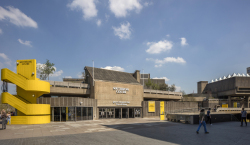"Should you always retrofit?" - Insights from our NLA talk with FCBStudios
19 January 2021
On Tuesday, FCBStudios joined us for our New London Architecture (NLA) talk to discuss an important question for our climate: "Should you always retrofit?"
Retrofitting existing buildings to make them more energy efficient is critical if the UK is to hit 2050 net zero carbon targets, but should you always retrofit or is it possible to be more sustainable by starting from scratch? This panel discussion, chaired by Peter Murray, Editor-in-chief at NLA, explored this vital question with panellists Andrew Leiper, Net Zero Carbon Leader at Max Fordham LLP, Kiru Balson, Senior Sustainability Consultant at Max Fordham LLP, Peter Clegg, Founding Partner at FCBStudios and Dr Joe Jack Williams, Associate and Researcher at FCBStudios.
Setting the scene, Andrew Leiper started off with an Introduction to MF Net Zero and our newly launched Net Zero Carbon Guide. An overview of the concept of 'retrofitting', decision making, the formula for deciding whether to retrofit or not as well as traditional ideas of retrofit and the need for analysis followed.
"Over the last 200 years our energy consumption has exploded, rising from around 5,000 TWh in 1800 to around 160,000 TWh in 2019 - a rise of 3200%! To limit further damage to the natural world and allow restoration of compromised land to its natural state we need to get a lot smarter about where we source our materials and how we reuse the materials we have already gathered." - Andrew Leiper, Max Fordham LLP
- The biggest carbon wins often come from replacing HVAC and Lighting
- There are often potential savings to be made by reusing plant area.
- Increasing site capacity without demolition can add value without carbon costs
- Decanting and phasing is one of the biggest issues to plan for
- There are huge embodied carbon savings in retaining foundations and structure
- We need to learn to love our brutalist legacy!
"We were the only people who said 'Maybe you should hang on to buildings like the Southbank Centre, because they have intrinsic value, they represent an era, but they also represent 22,000 tonnes of embodied carbon'. It's a huge input into the significant problem of trying to reduce carbon emissions immediately, not in the future. Renovation is not just retaining and improving, but in relatively low rise buildings adjacent to high rise, there is an opportunity of adding value, plan form and volume to the site as well. In every situation what we've done with these 1960s threatres we worked on with Max Fordham LLP, such as the Brighton Dome and Alexandra Palace, is reverse the flow of the ventilation to reduce energy consumption. Using diffusing ventilation, we were able to gain 10-15% efficiency. To make these retrofit installations work, we have to work closely with people like Max Fordham LLP." - Peter Clegg, FCBS
"Embodied carbon is becoming far more of a driver in terms of overall whole life carbon of a building. What we're finding with embodied carbon is that as an industry we're still trying to skill up and get good benchmarks; there's quite a lot of work going on! If we're aiming for net zero, and we are, we need to learn how to re-use our buildings." - Joe Jack Williams, FCBS
"The realisation of whole life cycle carbon benefits has tipped the equation for how we should approach retrofit in the first place. Alongside this, there is a greater number of discussions around wellbeing and how to optimise thermal comfort. So in principle, what this has brought is on equal terms the fabric and services as a tangible hand-in-hand solution that can deliver better results, and has enabled design teams to influence the social outcomes as a result of retrofits." - Kiru Balson, Max Fordham LLP


.jpg)